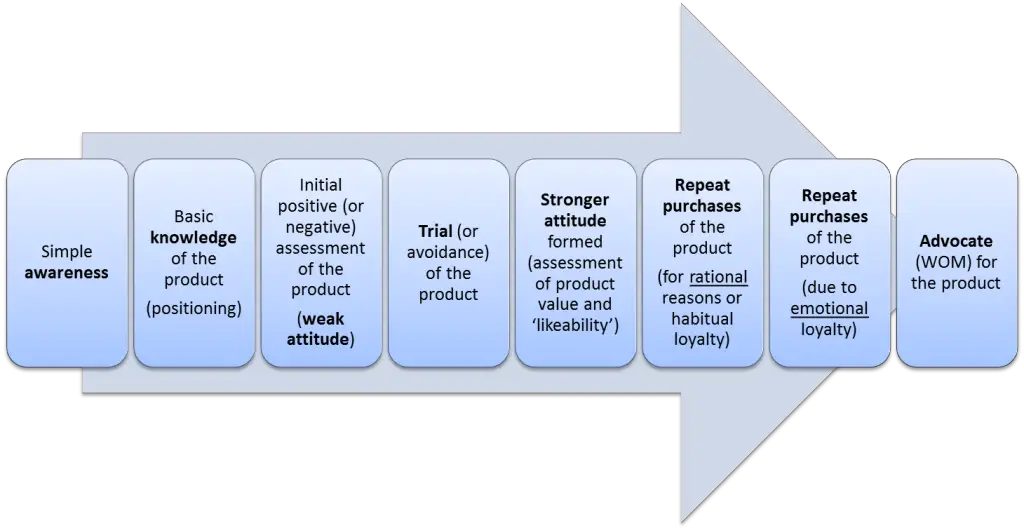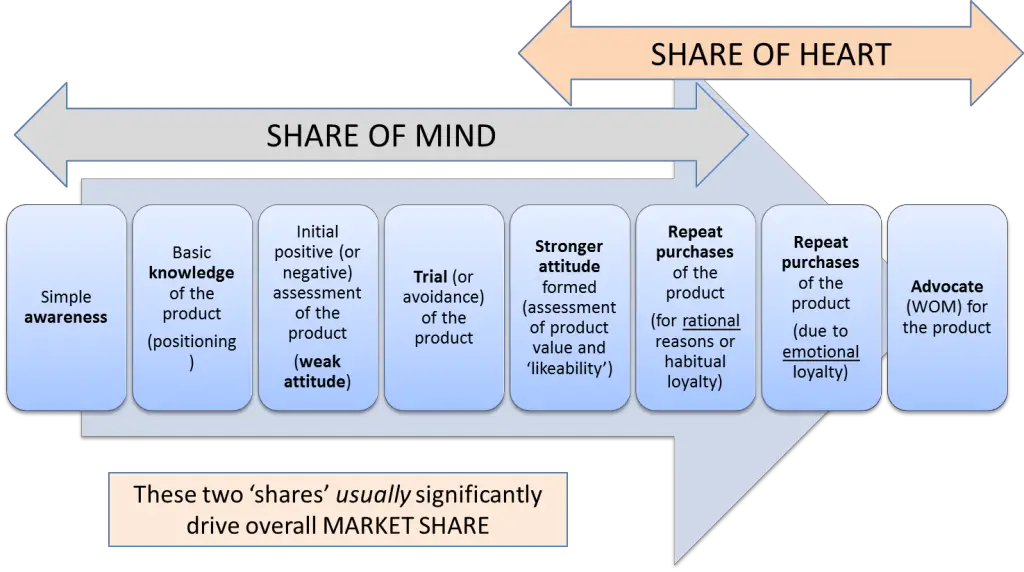Updated May 2023
Contents
“Share of Hearts” is a qualitative measure of marketing success. It differs from the more tangible metrics (such as market share, that is based on sales) and focuses on the less tangible aspects the consumers’ emotional engagement with a brand.
We could define share of hearts in such terms as:
- the degree to which the brand resonates with its target audience on an emotional level
- the brand’s ability to engender loyalty, emotional attachment, and affinity
- a measure of a brand’s emotional equity with its target markets
- the emotional connection and positive feelings a customer has towards a brand
As we can see, share of hearts metrics refer to an intangible, and somewhat subjective, emotional level of engagement and connection between the brand and the consumer (usually a customer).
To understand why share of hearts metric matter to a brand (given they are intangible and potentially somewhat vague), we need to review the Hierarchy of Effects model below.
The hierarchy of effects model is a marketing pathway that describes the knowledge and attitude steps customer journey towards the purchase of a product or service.
While there are numerous hierarchy of effects models that are covered in marketing literature, probably the most common one was developed in 1961 by Robert J. Lavidge and Gary A. Steiner in their 1961 article “A Model for Predictive Measurements of Advertising Effectiveness.”
This is a six stage model usually included in a Philip Kotler marketing textbook, where the consumer moves from initial awareness of a product to their final purchase, as follows:
- Awareness = this is where a consumer first becomes aware that a brand or product offering exists = we measure this through brand awareness metrics
- Knowledge = this is where the potential customer gains more information about the brand or product, gaining some sense of its positioning, benefits, and differentiation = we measure this through brand health metrics and perceptual mapping
- Liking = this is where the potential customer starts to develop and strengthen their (hopefully positive) attitude (opinion and assessment) toward the brand or product = we measure this through share of heart metrics
- Preference = this is where the potential customer’s attitude strengthens beyond liking to being a clear preference for the brand or product, often after considering competing offerings in the market = we also measure this through share of heart metrics (including brand preference and likability metrics)
- Conviction = this is an extension of preference above, to the point that the consumer’s mindset changes from potential customer to deciding to become a first-time customer of the brand (or product) = we will measure this by metrics such as purchase intent
- Purchase = finally the customer buys (trials) the brand or product for the first-time = we will measure this through market share and sales metrics, and potentially CRM information
You will note that ‘share of hearts’ metrics are identified in the above stages of the customer journey – especially for the progression from liking, to preference, to conviction.
Usually, for the consumer to progress through these stages, they need to have formed a positive view of the brand, and indeed, even formed a mild emotional connection with the brand (e.g. something like “sounds like a good brand for me”).
It is important to note that ’emotional connection’ to a brand can be quite simplistic – it doesn’t need to be “love” for the brand – just a strong liking and preference.
A More Modern Hierarchy of Effects Model
Let’s now build upon the above traditional hierarchy of effects model to also include post purchase loyalty, as well as ‘stepping stone’ attitudes.
The following diagram provides a revised framework, which steps through these stages:
- Awareness (as per the model above)
- Knowledge (as per the model above)
- Initial attitude (as per liking, preference, conviction above)
- Trial purchase (as per the model above)
- Stronger attitude (this differs from the above model, as this occurs AFTER the trial purchase and is driven by positive customer satisfaction – as we would measure this by using various share of hearts metrics)
- Repeat purchases due to habitual loyalty (where the customer is loyal due to habit, routine, and convenience)
- Repeat purchases due to emotional loyalty (where the customer is loyal due to a strong brand preference and some form of emotional connection to the brand)
- Advocate (being a promotor of the brand through word-of-mouth, and reviews )
As you can see, in this model there are eight stages that build in the hierarchy of effects aspects, along with actual purchase behavior and post-purchase behavior.
Therefore, this model can be considered a simple customer migration path or top-level customer journey, which probably encapsulates the ideal marketing pathways – taking an unaware consumer through the various communication stages to initial product trial to repeat purchase and then finally to a loyal supporter of customer.
Where Share of Hearts Fits In
As you can see from the above revised model, there is a commitment shift of the customer from rational loyalty to emotional loyalty.
Rational loyalty means that they are justifying the purchase decision based upon key product benefits.
However, emotional loyalty means that the consumer is now emotionally connected to the brand, likes the brand, and will deliberately seek it out.
In terms of marketing metrics, we typically look at both share of mind metrics and share of heart metrics.
Share of heart metrics typically measure the behavior and attitudes in the later stages of this customer migration path, as shown in the revised diagram below.
Here are some examples of metrics that can help measure “Share of Heart”:
Brand Loyalty
This can be measured through a combination of associated metrics, such as repeat purchase rate, customer retention rate, and customer lifetime value.
Brand Advocacy
This can be evaluated through Net Promoter Score (NPS), which assesses the willingness of customers to recommend your brand to others.
Customer Satisfaction
This is typically measured through customer satisfaction surveys, which can provide insights into how customers feel about your brand, product, or service.
Customer Engagement = This can be assessed through metrics such as social media engagement (likes, shares, comments), time spent on your website, or interaction with your brand through various touchpoints.
Emotional Connection = This can be estimated through focus groups, surveys and customer feedback, asking about brand trust, and a sense of personal connection with the brand.
Brand Perceptions = This refers to how consumers view your brand in terms of its personality and values. This can be measured through brand image surveys and perceptual mapping.
Customer Effort Score (CES) = This measures how easy it is for customers to interact with a brand. Brands that are easier to interact with can foster stronger emotional connections.
Social Media Sentiment Analysis = This involves analyzing comments and discussions about a brand on social media to understand how people feel about it. Positive sentiment can indicate a strong emotional connection.
Brand Advocacy Metrics = Metrics like referral rates and brand mentions can show whether customers feel strongly enough about a brand to advocate for it, indicating a strong emotional connection.
Customer Lifetime Value (CLV) = A high CLV can indicate a strong emotional connection, as it suggests customers are maintaining a long-term relationship with the brand.
Brand Switching Rates = This metric examines the rate at which customers switch from one brand to another. A lower brand switching rate suggests a stronger brand preference.
Share of Customer (or Wallet) =This measures the percentage of a customer’s total spending within a category that is devoted to a particular brand. A higher share of wallet can indicate a higher level of brand preference.
Brand Consideration Set (Evoked Set) = This measures the percentage of potential customers who would consider your brand when making a purchase decision.
Related Information
- Free Customer Journey Map Excel Template
- Key Parts of the Customer Journey
- When to use customer journey maps?
- What is a brand touchpoint?
- Advertising awareness and recall metrics
- Examples for calculating market shares
- Market Shares: Overview and Formulas
- Why We Need to Use Marketing Metrics
- Concerns with The Net Promoter Score (NPS)
- Understanding the Limitations of CSat


